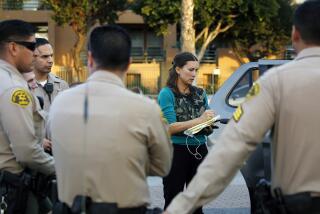History of violence
- Share via
Today, Sager and Wilkinson discuss public access to police records. Previously they debated proposed state legislation to restore public access to police hearings and debated several cities’ decisions to close disciplinary hearings. Later in the week, they will court cases and other issues related to officers’ privacy and public access.
Nothing has changed
By Alison Berry Wilkinson
The lawyer in me wants to answer today’s question”Should use-of-force records be reopened to the public?”with a resounding: “Objection! Assumes facts not in evidence.” Why, you ask? Because it begins with the presumption that the records were once accessible but are no longer.
Nothing in the current state of the law shields uses of force from scrutiny. Throughout the state, officers are required to document in detail uses of force in the crime report regarding any incident in which police action was required. These reports are then subject to intense examination and scrutiny by supervisors, police department management, and the district attorney’s office. Use of force reports remain accessible in the same manner as all other crime reports. The police receive no special protection.
This gets us back to the debate over what happens when it is suspected that an individual officer failed to properly apply force. If the officer is accused of misconduct, then the departmental investigation and resulting disposition of the allegation is confidential under the California Penal Code Section 832.7. Nothing about that has changed. Rather, the Supreme Court simply confirmed the practice of the vast majority of California law enforcement agencies in treating the material as confidential and corrected the mistaken presumption of the few cities (such as Los Angeles, San Francisco, Oakland and Berkeley) that ignored that law and publicized misconduct proceedings.
Uses of force are independently investigated regardless of whether misconduct allegations are levied. Take the use of deadly force. Every officer-involved shooting results in an immediate, intense, and detailed examination of the incident. Considerable resources are deployed to determine whether anyone involved in the incidentincluding the police officer who discharged his or her weaponcommitted a crime. These criminal investigations are frequently conducted by an independent, uninvolved police agency and/or the district attorney’s office. Where a death results, those criminal investigations are routinely examined in public coroner’s inquest hearings, open public grand jury proceedings, or in a criminal trial. These records remain accessible in the same manner as any other crime report. Nothing has changed.
Alison Berry Wilkinson is a partner at the law firm of Rains, Lucia & Wilkinson in Pleasant Hill, which represents more than 100 public safety labor organizations in California.
Give the public access to use-of-force records
By Kelli L. Sager
Alison,
It’s refreshing to see that we agree on something -- namely, that the public is entitled to detailed information about police use of force. I also am encouraged by your statement yesterday that police officers “know that the very nature” of their job “demands accountability,” another point with which I wholeheartedly agree.
Where we part company is in how this concept works in actual practice. Although your statements today would lead one to believe that the process is entirely transparent, from the “immediate, intense, and detailed examination of the incident,” through the “criminal investigation” (if any), and ultimately through “inquest hearings, open public grand jury proceedings, [and] in a criminal trial,” that unfortunately is not the case. Instead, as you know, there are many impediments along the way that have been used by police officers (and their lawyers) to forestall any information from being released about such inquiries, even to the point of withholding the names of officers who have used deadly force.
It is true, as you say, that if an officer’s conduct rises to the level of a crime -- and if there is a trial -- that proceeding is open to the public, just like every other criminal trial. In that sense, thankfully, “[t]he police receive no special protection” -- nor should they.
But it is precisely in the area that you downplay -- the investigation and review of alleged misconduct involving the use of force -- that the public has a substantial interest in accountability. But police, despite your protestations about their desire for public scrutiny, have worked steadfastly to maintain secrecy. In its recent Copley decision, which we have discussed previously, the California Supreme Court specifically disapproved an earlier Court of Appeal decision that had required a county sheriff to reveal the names of deputies who fired weapons during a criminal incident. The court found that the information related to an internal investigation, and therefore fell within the black hole of “disciplinary” information that is shielded from the public. Consequently, for you to suggest that the public has access to information about officers’ use of force, and that “nothing has changed” in this regard, is misleading, at best.
There is no dispute that police officers have very difficult and dangerous jobs. There also cannot be any serious dispute that there have been some police officers who have abused their positions of trust, particularly with respect to the use of force. The only way the public can feel confident that these incidents, however aberrant, are being handled properly is for the inquiry process to be transparent. Those officers who are doing their jobs well (and there are many of them) do not deserve to be tainted by the suspicions and distrust that inevitably arise whenever the government acts in secret. And officers who use excessive force -- particularly unjustified deadly force -- should be held accountable to the public for their actions.
Kelli L. Sager is a partner at Davis Wright Tremaine LLP in Los Angeles. She has represented The Times in efforts to gain access to information about California’s peace officers.
| | Day 3 | |
More to Read
Sign up for Essential California
The most important California stories and recommendations in your inbox every morning.
You may occasionally receive promotional content from the Los Angeles Times.













